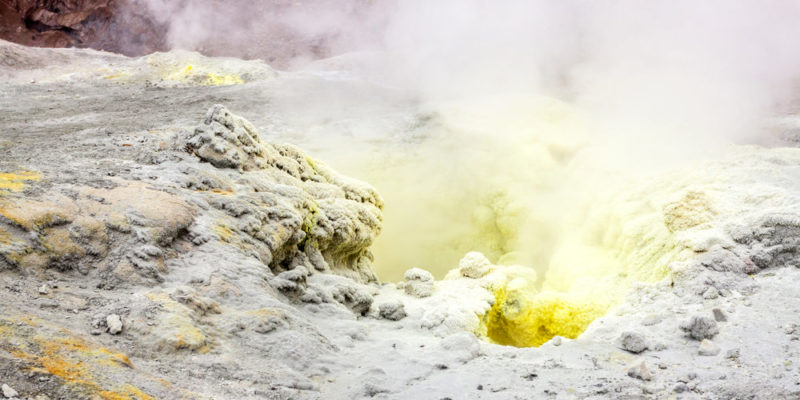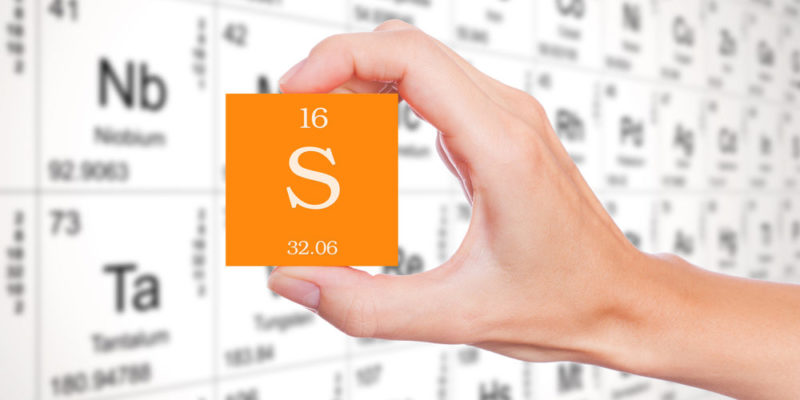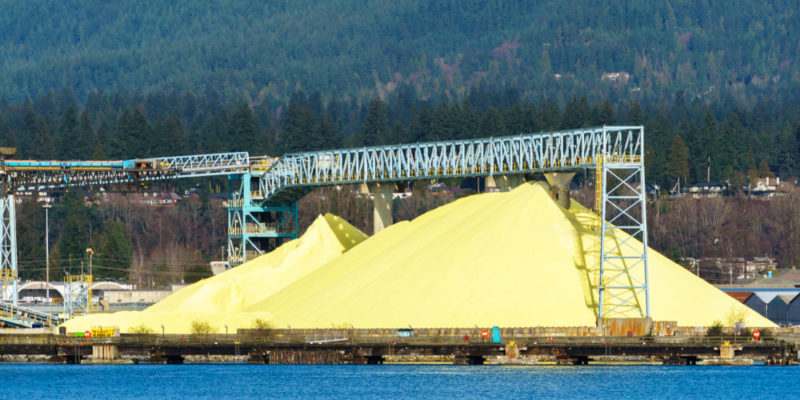We explain what sulfur is, where it is found and how this mineral is obtained. In addition, its characteristics, properties, uses and more.
What is sulfur?
Sulfur is a chemical element , classified within the group of non-metals , which is found abundantly in nature. It has a characteristic rotten egg smell, it appears in strong lemon yellow, brownish or orange color. It is insoluble in water but soluble in carbon disulfide (CS 2 ), and flames with a blue flame emitting sulfur dioxide (SO 2 ).
Atomic number 16, its chemical symbol S . It belongs to group 16, period 3, block p of the Periodic Table. Its atomic mass is 32.065 (5) u, its electronic configuration [Ne] 3s 2 3p 4 , electrons per level 2,8,6; It is multivalent and common oxidation states are -2, +2, +4, +6.
Origin of the word Sulfur
Etymologically it comes from the Latin sulphurium , this in turn from the Sanskrit ?ulb?ri , a term that means " copper loses its value when joining sulfur." It was also called "flammable stone".
Sulfur history

Sulfur has been known since ancient times. In the Greek and Roman cultures medicinal properties were attributed to him and it was used in the whitening of fabrics; the Egyptians used it for the purification of the temples.
It played a leading role in the doctrines of the ancient alchemists, who considered this element as the missing component in the philosopher's stone to be able to make artificial gold .
Sulfur has been known since time immemorial, but as an element it was discovered by Henning Brand. An amateur merchant and alchemist from Hamburg (who also discovered phosphorus (P)). However, it was the French chemist Antoine Lavoisier who through a series of experiments conducted in 1777 discovered that sulfur is an element rather than a compound and was the first to classify it as a chemical element.
Where is sulfur found?

Free sulfur is found in volcanic deposits, hot springs , and also in underground deposits, mainly in the USA (Texas, Louisiana), Russia, Japan , Canada, France , Mexico , Poland and Sicily.
In the combined state it appears in the form of sulfides (pyrite and galena) and sulfates (gypsum) , in numerous minerals. It is also found in a wide variety of organic compounds such as animal proteins and some vegetables .
How is sulfur obtained?

Obtaining sulfur is carried out mainly through the Frash Process , a method to extract the element from the depths of the earth, melting the sulfur contained in underground deposits (it is a system similar to that of oil exploration).
Sulfur is also obtained from the separation of natural gas that contains hydrogen sulfide (H 2 S), through the oxidation process. It is also extracted from oil , from the smelting of rocks that contain it, and from manual collection in deposits of pure sulfur combined with volcanic ash.
Sulfur characteristics

- As a non-metal , it is characterized by having no shine or luster.
- It does not reflect light and, in its natural state, it comes in a lemon yellow color.
- Its consistency is solid but soft and brittle.
- It is a poor conductor of heat and insulator of electricity .
- Its melting point is relatively low.
- It has four natural isotopes: 32 S (95.02%), 33 S (0.75%), 34 S (4.21%) and 36 S (0.02%); twenty unstable with a half-life that ranges from 21 milliseconds, in addition to 35 S (whose half-life is 87.32 days).
Structural forms of sulfur
 Sulfur occurs in different forms or allotropes in the solid, liquid and gaseous phases:
Sulfur occurs in different forms or allotropes in the solid, liquid and gaseous phases:
- Solid sulfur is made up of a molecular structure of eight- atom misshapen rings and takes one of two crystalline forms: the orthorhombic octahedron (S?) and the monoclinic prism (S?). The arrangement of the molecules determines the forms listed, whose transition temperature from one to another is 96 ° C. At room temperature the transition of the form is slower.
- By raising the temperature , it turns into a transparent yellow and fluid liquid , which exhibits changes in its properties and structure. The color turns brown and thick and becomes clear again when it reaches the boiling point, turning into a red and viscous liquid. These changes in shape occur when the sulfur rings separate and break as a result of combustion. Cooling the viscous liquid produces a gummy mass called plastic sulfur. Once it cools, it crystallizes, adopting the rhombic structure.
- In the gas phase at 780 ° C it takes on a balanced form of mixing with diatomic molecules. Above 1800 ° C the molecular separation is complete and sulfur atoms are found.
Atomic Properties of Sulfur
- Average radius: 100 pm
- Electronegativity: 2.58 (Pauling scale)
- Atomic Radius (calc): 88 pm (Bohr Radius)
- Covalent Radius: 102 pm
- Van der Waals radius: 180 pm
- Oxidation state (s): ± 2, 4.6 (strong acid)
- 1st ionization energy: 999.6 kJ / mol
- 2nd ionization energy: 2252 kJ / mol
- 3rd Ionization energy: 3357 kJ / mol
- 4th Ionization energy: 4556 kJ / mol
- 5th Ionization energy: 7004.3 kJ / mol
- 6th Ionization energy: 8495.8 kJ / mol
Sulfur physical properties
- Ordinary state: Solid
- Density: 1960 kg / m 3
- Melting point: 388.36 K (115 ° C)
- Boiling point: 717.87 K (445 ° C)
- Enthalpy of vaporization: 5 kJ / mol
- Enthalpy of fusion: 1.7175 kJ / mol
- Vapor pressure: 2.65 × 10 -20 Pa at 388 K
- Critical point: 1314 K (1041 ° C) (20.7 MPa)
Uses of sulfur
 Most of it goes to the production of sulfuric acid (H 2 SO 4 ), one of the most important chemical products, used in turn in the production of fertilizers from phosphates and ammonia.
Most of it goes to the production of sulfuric acid (H 2 SO 4 ), one of the most important chemical products, used in turn in the production of fertilizers from phosphates and ammonia.It is also used in rubber vulcanization , soap making, detergents, cements, electrical insulators, plastics , explosives, bleaches, dyes, drugs , paints , paper, and petroleum refining.
In addition, it calms the symptoms of skin diseases , it is ideal for treating eczema and allergic skin reactions. Eliminates toxins, which is why it is usually incorporated in anti-acne and anti-grease products.
Nutritional properties of sulfur
 The consumption of foods rich in sulfur benefits health and provides nutrients to the body. Its presence is recognized by the spicy taste. Some of the foods richest in sulfur are:
The consumption of foods rich in sulfur benefits health and provides nutrients to the body. Its presence is recognized by the spicy taste. Some of the foods richest in sulfur are:
- Vegetables . Broccoli, cabbages, turnip; garlic and onion; cucumber, pepper, aubergines; soybeans, lentils, beans; mango, grapefruit, orange, plum, pear, banana, apple; sunflower seeds, oats.
- Carnes . Fish and shellfish
Sulfur Cycle
Sulfur circulates through the biosphere as follows:
- From the soil , air or water to the vegetables by absorption.
- From vegetables to animals by ingestion.
- It reaches the atmosphere in the form of gases emitted by decomposition of organic matter (hydrogen sulfide - H 2 S and sulfur dioxide - SO 2 ) or volcanoes .
- It returns to the soil and water by depositions, rain or decomposition of living beings and by penetration of the atmosphere by gases.
- Acid rain : the SO 2 accumulated in the atmosphere can combine with another oxygen atom to form sulfur trioxide (SO 3 ) which, in contact with atmospheric humidity, becomes sulfuric acid (H 2 SO 4 ), which is harmful to life . It precipitates to the surface in the form of “acid rain”. To combat acid rain, it is necessary to reduce polluting gas emissions, save energy and reduce the consumption of fossil fuels that contain sulfur.
World production and sulfur reserves
 Natural sulfur reserves are 5,000 million tons . Half of the sulfur used in industry is obtained by desulfurization of natural gas and oil, converting sulfur compounds into hydrogen sulfide. Recovery from nature reserves is expensive and there are higher regulations on environmental pollution .
Natural sulfur reserves are 5,000 million tons . Half of the sulfur used in industry is obtained by desulfurization of natural gas and oil, converting sulfur compounds into hydrogen sulfide. Recovery from nature reserves is expensive and there are higher regulations on environmental pollution .It is estimated that the sulfur present in fossil fuels dates back to 600 million tons . Annual production is 63 million tons. The main world producer is the United States (10 million tons) followed by Canada (8.5 million tons) and Russia (6.8 million tons).
Negative effects of sulfur on health
 Natural sulfides and sulfur oxides obtained from industrial processes can have harmful effects on human health. To avoid them, safe handling practices should be followed. Can produce:
Natural sulfides and sulfur oxides obtained from industrial processes can have harmful effects on human health. To avoid them, safe handling practices should be followed. Can produce:
- Neurological and cardiac damage
- Behavioral changes
- Impaired circulation and respiration
- Impairment of the senses: sight and hearing
- Impairment of the reproductive and immune system and hormonal metabolism
- Stomach and gastrointestinal disorders
- Damage to liver and kidney functions
- Skin irritation on contact
- Irritation of lungs and mucous membranes by inhalation
Sulfur toxicity
Sulfur is not poisonous in small concentrations, although it is irritating to the mucosa and can be metabolized , but in high concentrations it can cause respiratory arrest.Sulfur dioxide (SO 2 ) is an atmospheric pollutant gas , it produces acid rain by transforming into sulfur oxide SO 3 . Carbon disulfide CS 2 is highly flammable, ingestion in small amounts can cause paralysis.
The above content published at Collaborative Research Group is for informational and educational purposes only and has been developed by referring reliable sources and recommendations from experts. We do not have any contact with official entities nor do we intend to replace the information that they emit.
Abubakr Conner brings a diverse skill set to our team, and covers everything from analysis to the culture of food and drink. He Believes: "Education is the most powerful weapon that exists to change the world." .
Leave a reply
Your email address will not be published. Required fields are marked *Recent post

Sport: What Is It, Types, Risks, Features, Characteristics and Examples

Dogs: Emergence, Features, Characteristics, Feeding and Breeds

Story: Definition, Elements, Structure, Features and Characteristics

